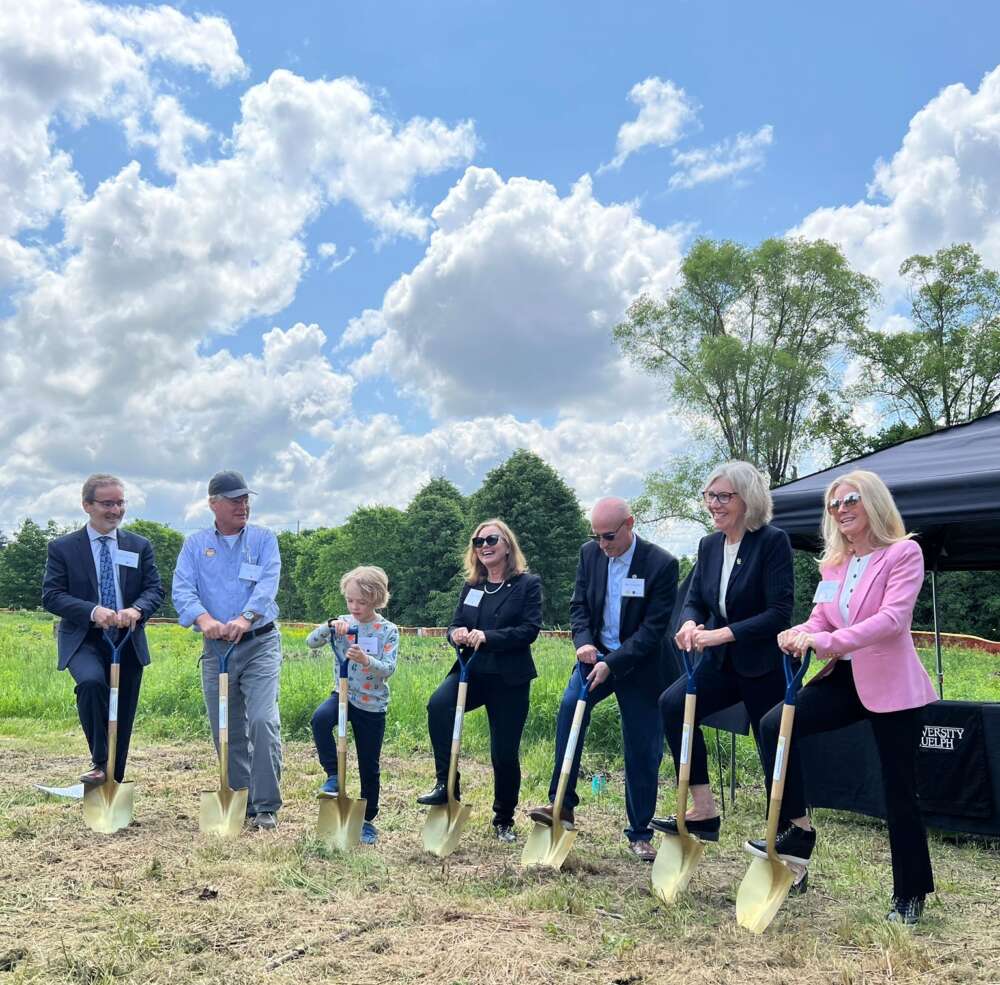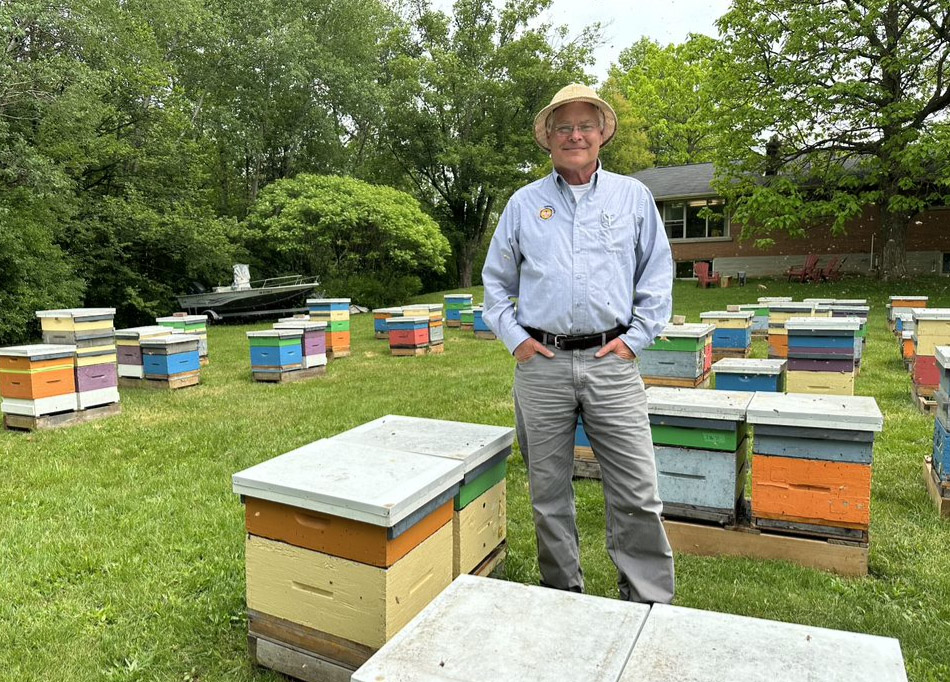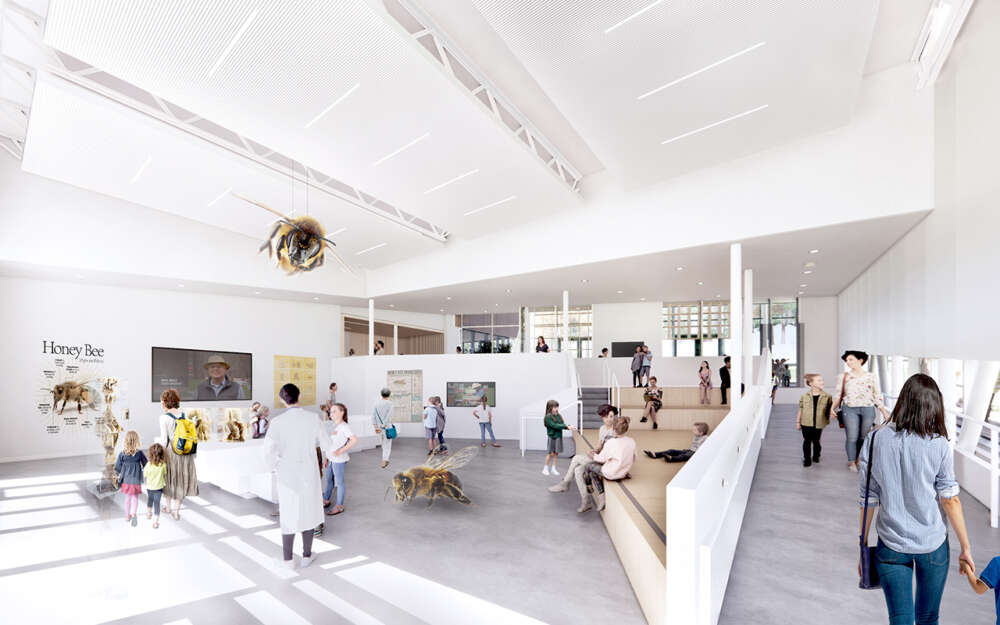Reducing ongoing honeybee colony losses is part of the ultimate goal for a state-of-the-art Luckevich Pinchin Honey Bee Research Centre (HBRC) to be operating by 2025 at the University of Guelph.
A groundbreaking event on June 14 has kicked off construction of the $16-million centre, planned as a needed upgrade to the existing pollinator research, teaching and public outreach hub that already looks after the largest number of honeybee research colonies in North America.

The new 15,000-square-foot centre will feature indoor and outdoor education spaces, classroom and event space, a laboratory, bee breeding facilities and pollinator gardens, and will be built near Townsend House, the longtime HBRC home on Stone Road.
“This new Honey Bee Research Centre will allow us to scale up research and outreach,” said Dr. John Cranfield, Ontario Agricultural College (OAC) associate dean external relations.
“The new facility will give the centre space to grow its engagement with apiarists, with community members interested in learning more about pollinators and honeybees, and with young people looking to be a part of positive change to support pollinators and to ensure a healthy environment and a safe food supply.”
Among donors to the project, Lydia Luckevich, a 1979 U of G chemistry alumna, will provide $7.5 million. The centre will be named for her and for her late husband, Don Pinchin, founder of Pinchin Ltd., an environmental consulting firm.
Luckevich met several years ago with OAC faculty and administrators to discuss ideas for an updated research centre and her role in supporting the concept.
Envisioning a busy hub on campus accommodating numerous visitors from beekeepers to school groups, she said, “I feel gratitude for everybody who has worked so hard to make this centre happen.”
New facility to enhance bee research, teaching, outreach

The HBRC has operated since 1894 as part of U of G’s OAC. For decades it has occupied a repurposed 1960s-era bungalow on campus near the U of G Arboretum. That existing space needs upgrading for growing outreach and research activities, said Cranfield.
Some 4,000 people visit the centre each year; Cranfield said the new facility might accommodate five times that number of visitors, ranging from hobby and commercial apiarists to school groups and community members.
Researchers at U of G and elsewhere use the centre to investigate the causes and potential solutions for recent declines of honeybee colonies, said Paul Kelly, research and apiary manager with the HBRC.
Recent and ongoing research projects include breeding of bees resistant to varroa mites, studying essential plant oils and organic acids for use as naturally occurring miticides, and investigation of prebiotics, probiotics and protein-based nutrition supplements to counter bee gut parasites.
Kelly said the new centre will provide improved laboratory space for bee breeding and incubation as well as enhanced facilities for various research projects involving U of G faculty members, students and other collaborating investigators.
Currently the U of G facilities accommodate research, teaching and demonstrations and queen breeding in the same apiary. The new quarters will allow for those functions to take place in separate, dedicated apiaries for greater efficiency and improved health of hives and bees.
The building will also provide more dedicated space for popular education programs that attract a range of professional and backyard beekeepers as well as schools and other groups. Currently, those sessions run only in spring and fall but will be offered year-round in the new facility.
“We’re teaching every day and we lack space here,” said Kelly.
Centre to include ‘bee tree forest’ of pollinator-friendly plants

The new quarters are also expected to improve the centre’s beekeeping facilities and logistics.
U of G manages the largest number of research honeybee colonies of any institute in North America. Centre staff tend about 100 hives in the apiary located on the U of G property as well as another 200 hives at the nearby Arkell Research Station and 12 privately run farms within 20 minutes’ drive of campus.
The new centre will be located near the existing bee yard on the site of a former tree nursery run by U of G’s grounds department.
Kelly said the new centre will adjoin a planned “bee tree forest” of pollinator-friendly trees such as basswood, maples and willows as well as shrubs to be planted on the site. Along with nearby gardens, he said, the area will be used for outdoor education, including sessions run for homeowners looking to attract bees and other pollinating insects and wildlife to their gardens.
“Of all the things you can do to benefit bees, the number one thing is to provide bee habitat and forage,” said Kelly.
The new HBRC building was designed by Moriyama Teshima Architects, also designers of the nearby OAC Centennial Arboretum Centre opened in 1974.
OAC alumni and especially the Class of ’79 have been major supporters of the new centre. As of mid-June, U of G had raised more than 80 per cent of the $16-millon price tag for the project.
For more information, including numerous how-to videos on beekeeping, check out the HBRC’s YouTube page.
Contact:
Paul Kelly
pgkelly@uoguelph.ca
Shannon Fawns
fawnss@uoguelph.ca
